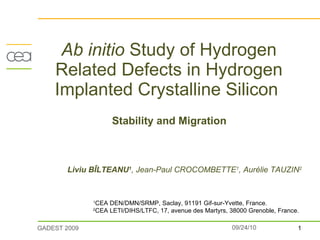
Hydrogen Related Defects (results)
- 1. Ab initio Study of Hydrogen Related Defects in Hydrogen Implanted Crystalline Silicon Stability and Migration Liviu BÎLTEANU 1 , Jean-Paul CROCOMBETTE 1 , Aurélie TAUZIN 2 1 CEA DEN/DMN/SRMP, Saclay, 91191 Gif-sur-Yvette, France. 2 CEA LETI/DIHS/LTFC, 17, avenue des Martyrs, 38000 Grenoble, France.
- 6. Atomic and Molecular Interstitials Atomic H on different sites in [111] direction Atomic H interstitals Bi-atomic structures
- 7. Stability of Atomic and Molecular Interstitials
- 8. Charged Atomic Hydrogen Diagram Formation energy (with respect to free H atom) in function of Fermi Level for ALL sites and charge states. Negative U – 0.32 eV exp. 0.36 eV [1] [1] N. M. Johnson et al., Phys. Rev. Lett. 73 , 130 (1994). NEGATIVE U - EFFECT 2H H + + H - + 0.32 eV 2H -> H + + H -
- 13. Hydrogenated Vacancies q = -2 q = -1 q = 0 q = +1 q = +2
- 14. Possible elementary process Elementary processes involving H atoms Reaching the most stable VH n type structure, that is VH 4 Elementary processes involving also H 2 molecules
Notas do Editor
- Bonjour! Je vais vous présenter l’avancement des travaux liés à ma thèse sur la simulation atomistique de implantation de l’hydrogène en silicium. Cette thèse encadré par Jean-Paul est faite en collaboration avec le LETI de Grenoble, représenté notamment par Mme. Aurélie Tauzin.
- Voilà le plan de la présentation: Une petite introduction au procédé Smart-Cut suivi par la présentation des quelques résultats à la fois définitifs à la fois préliminaires sur les différentes structures possible de l’hydrogène en silicium c.a.d Les atomes et les structure biatomiques; Les défauts hydrogénés – notamment les lacunes hydrogénées; Les « platelets » - le défauts bidimensionnelles sur la formation desquels on s’intéresse. Finalement, les conclusions après le travail de cette année et si le temps me permettra, la liste des mes activités scientifiques.
- SMART-CUT est un procédé implémenté principalement par SOITEC, qui est leader européen sur la marché SOI. Les étapes du SMART-CUT sont présentés dans la figure sur ce transparent. Parmi ces multiples étapes nous sommes intéressés a cette étape – ci qui consiste dans l’accumulation de l’hydrogène en platelets pendant le recuit.
- Au cours de la formation des platelets, les donnés expérimentales montrent que plusieurs défauts (que j’ai listé sur ce transparent) interviennent. Nous ne sommes pas encore capable de dire quels sont les mécanismes entrainant ces défauts qui mènent aux platelets. On peut, par contre, caractériser ses défauts à l’équilibre ce qui nous permets proposer des différents scenarios de formation favorables de point de vue énergétique.
- Le deuxième type (en ordre de la complexité) sont les défauts biatomiques. Ces défauts biatomiques peuvent être classifié selon leur structure en: Interstitiels qui sont des molécules situées dans les sites T et H. Complexes biatomiques qui sont des structures formées par deux atomes d’hydrogène situés dans deux sites très proches. La dernière catégorie peut être divisés en deux sous-classes: Défauts axiales – les atomes se trouvent sur la même direction crystallographique. Défauts non-axiales – les atomes se trouve sur deux directions crystallographiques différentes. Donc une « zoologie » entière des défauts moléculaire.
- Nous avons étudié toutes ces structures mono- et di- atomiques dans les états neutres et chargés. Les résultats sont présentés de manière synthétique sur ce transparent. Afin de pouvoir comparer (en déduire la stabilité): nous avons prit pour zéro l’énergie de l’atome dans le site le plus stable. Les conclusions sont les suivantes: Les structures diatomiques chargées ont une énergie très haute, donc elles sont négligeables. Les molécules sont les structure neutres les plus stables en particulière la molécule interstitielle dans le site T. Les structures diatomiques peuvent être classifié de point de vue énergetique en trois catégorie: interstiels, des complexes liés, quas-liées et pas-liés. Dans la série « charge positive »: l’hydrogène en BC est la structure la plus stable; Dans la série « charge négative »: l’hydrogène en AB est la structure la plus stable. Dans cette série les on a trois configurations énergetiquement très proche et trois qui sont à aprox. 0.40 eV de ce « pluton ».